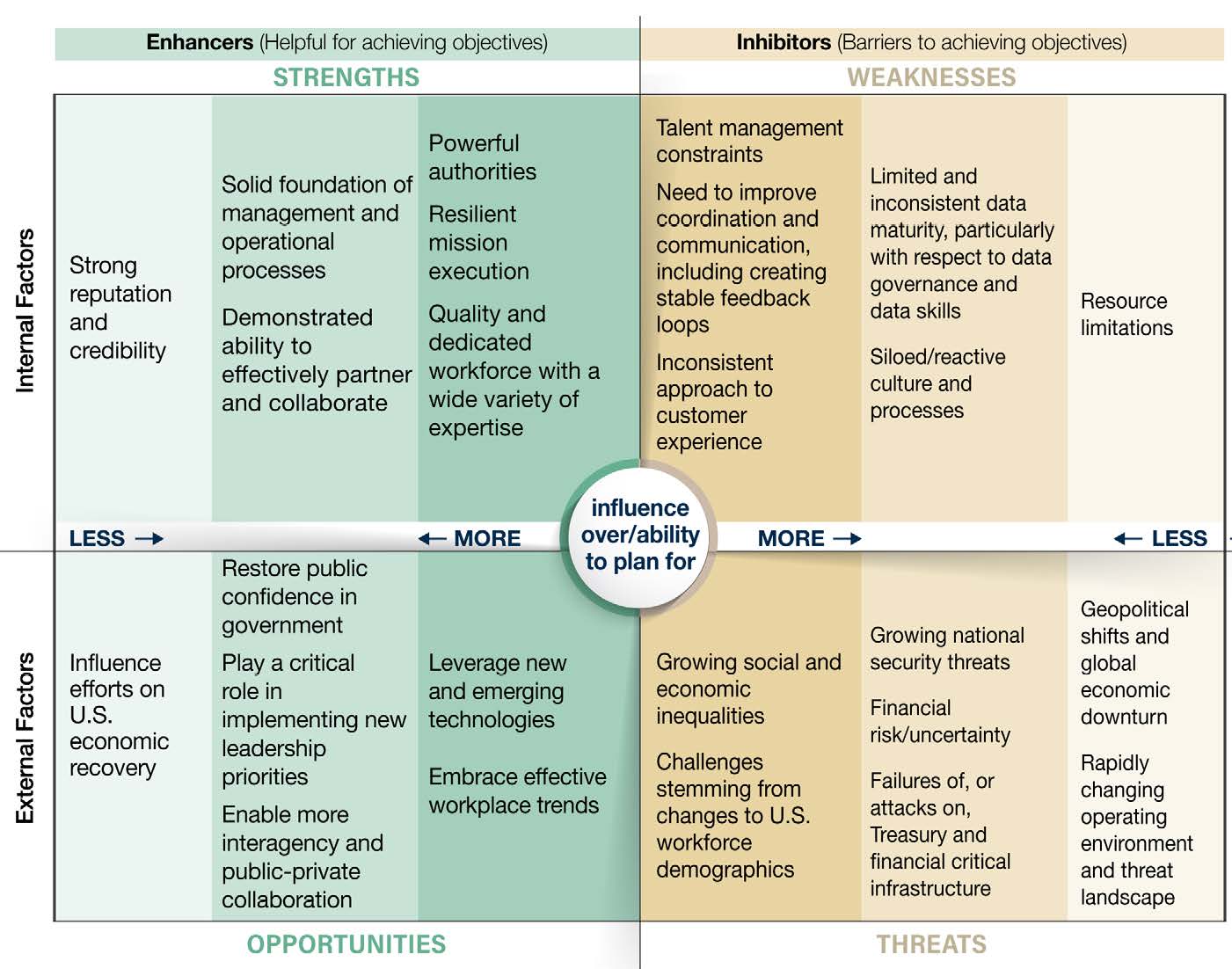To shape the Department’s Strategic Plan, Treasury conducted a rigorous scan of its operating environment to identify factors that may impact its strategic priorities and ability to achieve its mission over the next four years. The resulting Strengths, Weaknesses, Opportunities, and Threats (SWOT) assessment reflects the key internal (strengths, weaknesses) and external (opportunities, threats) factors that impact the Department’s operating environment, as well as the level of influence that Treasury has over each factor.
STAKEHOLDER ENGAGEMENT
Treasury engaged with internal and external stakeholders to identify ongoing and emerging priorities for the Department. These initial engagement activities resulted in an environmental scan that Treasury leaders used, along with the findings of the Department’s annual strategic review, to identify draft strategic objectives for the new plan. The Deputy Secretary of the Treasury chaired a series of planning sessions with the Department’s senior leaders to further refine these priorities, clarify desired outcomes, and develop strategies to achieve these objectives. In addition to the process described below, Treasury met with Strategic Planning teams of other federal agencies to obtain feedback on draft priorities and conducted a public outreach campaign to gather input from underserved populations on how Treasury can better support them.
| Sources | Deliverables | Final Outputs |
|---|---|---|
|
Leadership interviews: 23 interviews with 64 senior career and bureau leaders Feedback from 3 Congressional committees, other federal agencies, and the public Treasury documents and reports: ~45 sources including bureau strategic plans, annual reports, Inspector General reports, Human Resource workforce analytics, Strategic Objective Annual Reviews, and Quarterly Performance Reviews Planning sessions with Treasury senior leaders External articles and research: ~135 sources including other agency strategic plans, think tank articles, academic research |
Environmental can, including SWOT assessment and Change Agenda Treasury Learning Agenda List of Critical Programs and Projects Critical Management Initiatives Research on external factors, upcoming legislation, and party priorities |
Treasury FY 2022-2026 Strategic Plan Aligned to Bureau-level, community, council, office strategic plans and priorities |
UNDERSTANDING THE UNIQUE STATUS OF TRIBAL GOVERNMENTS
As referenced in President Biden’s Memorandum on Tribal Consultation and Strengthening Nation-to-Nation Relationships executed on January 26, 2021, American Indian and Alaska Native Tribal Nations are sovereign governments recognized under the Constitution of the United States, treaties, statutes, Executive Orders, and court decisions. Treasury is committed to strengthening its relationships with Tribal governments and Indian Country to work to better understand and respond to the needs of Tribal governments regarding agency policies, programs, services, regulations, guidance and other policy statements or actions that have Tribal implications. To further its commitment to recognizing our unique government-to-government relationship with Tribal Nations, Treasury has also adopted an Action Plan for improving its engagement with Tribal governments. (For more information, please see Treasury’s Tribal Consultation Policy and the Treasury Action Plan to Improve Tribal Relations.) As part of this commitment, Treasury held an initial consultation on the development of the FY 2022-2026 Treasury Strategic Plan and is committed to holding additional consultation once the plan is published and available for Tribal Leaders’ review.
Risk Appetite
To further understand Treasury’s operating environment, the Office of Risk Management conducted a risk appetite analysis and identified the amount and type of risk Treasury is willing to accept, on a broad level, in pursuit of its goals and objectives. Low appetite means that there is a preference to reduce risk as much as possible through mitigations. Moderate appetite implies that there is a willingness to accept some risks strategically and mitigate all others. Treasury acknowledges that sometimes risks must be accepted to pursue opportunities. The Department integrated thoughtful analysis into strategic planning processes to determine the level of risk that can be accepted and align strategic decisions with the risk appetite.
Treasury has a low risk appetite for conducting fundamental mission activities and critical programs and projects, which include programs or projects that are essential to Treasury’s successful execution of its mission. Failure, interruption, or compromise of these programs and projects could undermine Treasury’s capability to achieve its objectives, severely impact government operations, and result in significant loss of trust in Treasury, Federal Government, U.S. Economy, and National Security by key stakeholders or the public. The Department identifies these critical programs and projects at the goal level (see page 48 for list). Treasury has a moderate risk appetite for taking positive risks to implement and execute Treasury’s long-term goals and specific strategies.

